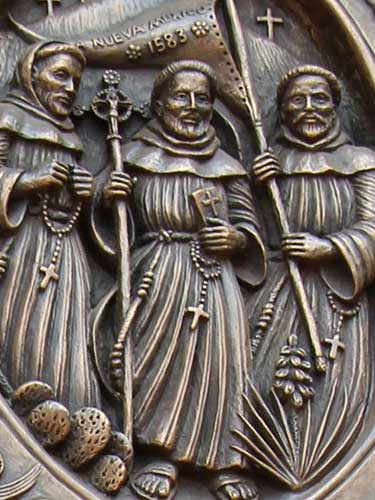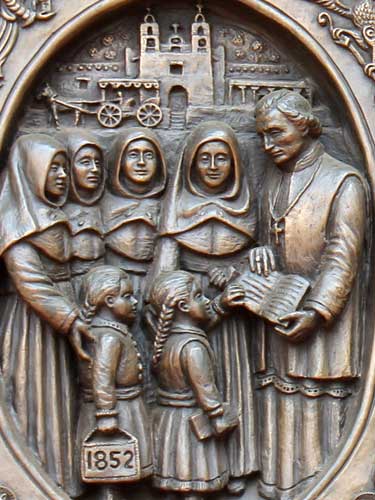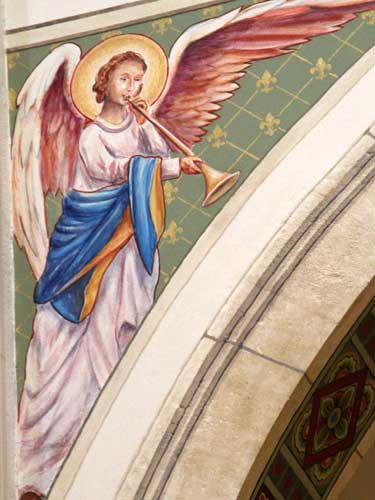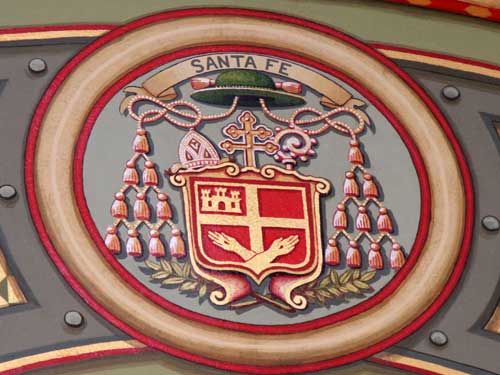LOS ALAMOS & SANTA FE (Day 3 - part 4)
The town of White Rock began in 1947 as temporary housing for the construction workers of Los Alamos. It was basically abandoned by 1953, and by 1958 all the old buildings had been demolished or removed. The town was built up again in 1963.
The overlook gave us an amazing 270 degree view of White Rock Canyon, a 1,000-foot deep canyon carved by the Rio Grande.

The overlook


Bill, Joanne and the Rio Grande!

Farther downstream the canyon narrows and is flooded by the Cochiti Dam reservoir.

The Rio Grande (meaning Big River) rises in the Rio Grande National Forest in Colorado, flows some 1,900 miles, then dumps into the Gulf of Mexico.

In the distance is the Sangre de Cristo mountain range.

The Black Mesa (in the distance), located in the San Ildefonso Pueblo lands, is a volcanic plug. It was formed millions of years ago when the magma from an active volcano hardened within its neck or a vent. The surrounding sediment was eventually eroded away.

Short but steep trails actually lead down to the river far below.

There are over 20 different species of cholla cactus in the deserts of the Southwest, each having adapted to different climate conditions and elevation. The name refers to shrubby cacti with cylindrical stems and segmented joints as opposed to fleshy pads.

A pair of robber flies are busy making more robber flies. Also called assassin flies, these powerful, aggressive, predatory insects feed on other insects, waiting and ambushing their prey as it flies past. Notice the robber fly on the right actually has an insect within its grasp.
We drove back down to Santa Fe via the same artsy stretch of highway 285 along Pojoaque.

Leaving the mesa tops

What I really enjoy about the southwest is the incredible skies!


Posuwaegeh is the Tewa name for Pojoaque.

Once back in the city, we made our way to a downtown parking lot next to the cathedral.

Downtown Santa Fe
The Cathedral Basilica of St. Francis of Assisi (or more simply Saint Francis Cathedral) is a Roman Catholic church, built from 1869 - 1886 on the site of an older adobe church. It was designed in the Romanesque Revival style with round arches, Corinthian columns and square towers (originally planned to be topped with dramatic steeples but they ran out of money). It became a basilica in 2005.
The word basilica comes from the Greek meaning 'royal house.' Originally it was more of just an architectural style. In the Catholic tradition, however, a basilica is a church that has been given special privileges by the pope. There are two kinds: major and minor basilicas. Since there are only four major ones (all in Rome), everything else is a minor one.
Minor basilicas were traditionally chosen because of their historical value, architectural/artistic worth, and/or significance as a center of worship. There are over 1,580 worldwide, 325 in the Americas and 69 in the US.

Cathedral Basilica of St. Francis of Assisi

Saint Francis of Assisi (aka Giovanni "Francesco" di Pietro di Bernardone, 1181/1182 - 1226)
Saint Francis was born in Italy. The son of a a prosperous silk merchant, he lived a life of luxury. While off at war in 1204, he had a vision which sent him down a path of spiritual enlightenment. He devoted himself to poverty and began preaching repentance on the streets with cheerful songs that made deep impression on people.
But Francis wasn't just interested in people; he was determined to 'bring the Gospel to all God's creatures,' whom he believed were his brothers and sisters. He preached to the birds and supposedly even persuaded a wolf to stop killing if the local villagers agreed to feed it. In 1210, the pope consented to founding the " Franciscan Order."

Archbishop Jean Baptiste Lamy (1814 - 1888) was responsible for the construction of the cathedral in a French architectural style that was familiar to him. That and he also disliked the regional adobe style.

The practice of a jubilee year has ancient roots that can be found in the Old Testament. A jubilee year was called every 25 years and was seen by the Catholic church as 'a time for remission of sins and universal pardon focusing on God's forgiveness and mercy.' The period of prayer is held from the Feast of the Immaculate Conception (December 8) to the Feast of Christ the King (November 20).

Apparently this was an Extraordinary Jubilee of Mercy because it's taking place outside of the normal cycle. Apparently Pope Francis just felt the world needed an extra one.



The giant bronze doors (sculpted by Donna Quastoff) were added in 1986. Each of the panels depict events in the church's history.

Antonio de Espejo was sent by Philip II of Spain to oversee the religious conversion of New Spain. In addition to his mission of finding any friars who were still alive, he also hoped to investigate the local mining prospects.

The province of Nuevo Mexico was officially settled during the 1598 expedition by Juan de Oñate y Salazar. Their major goal was to spread Catholicism. The city of Santa Fe was officially founded in 1610.
Nuevo Mexico got its name from early Spanish explorers who believed the area contained cities of gold similar to those of the Aztec Empire (centered in the Valley of Mexico). And so they called the land Santa Fe de Nuevo Mexico (Holy Faith of New Mexico).

Franciscan friars bring a small, wooden statue (called La Conquistodora) arrived in Santa Fe in 1625. She went on to be the oldest Madonna statue in the US.

In 1821, the Santa Fe Trail officially opened for trade.

When Jean Baptisite Lamy was appointed by the church to the New Mexico Territory in 1850, he needed help spreading the faith. The first answer his plea were seven Sisters of Loretto. They made the arduous journey from Kentucky, enduring bad weather, Indian country and even losing their Mother Superior to a cholera epidemic. They arrived in Santa Fe in 1852 and opened the Academy of Our Lady of Light (Loretto) in 1853.

Lamy blesses the completion of the cathedral in 1886... although technically it wasn't finished enough to be consecrated until 1895 (seven years after Lamy’s death). Technically again, it was NEVER actually completely finished since the original plan involved giant spires. Note the old adobe church of La Parroquia (built in 1714) still stood in the above photo. It had mud floors, and when it rained, one had to carry an umbrella... inside! The previous church on this site (built in 1626) was destroyed in the 1680 Pueblo Revolt.

The door handle
We headed inside...


Once covered over with white paint, the 1908 stencils of the Adoring Angels from the Book of Revelation have once more reappeared.

Modern technology sneaks its way in.

This is the archbishop's coat of arms. On the shield is a gold cross, signifying the name of the city (Santa Fe means Holy Faith). The tower is from Castile (a kingdom in Spain during the Middle Ages) and the crossed arms are of Christ and St. Francis of Assisi. Red and gold are traditional Spanish colors. Above the shield is a hat called a galero with ten tassels on each side. This was originally a pilgrim's hat like a sombrero. Its color and number of tassels varied based on the rank of the cleric. It was red with 15 tassels for cardinals, green with 10 tassels for archbishops, green with six tassels for bishops, etc. I wonder if this odd mix of hat and tassel colors is because the church is both a cathedral (run by a bishop or archbishop... green) and a basilica (considered important by the pope.. where cardinals have red)? Or maybe it's because this is Santa Fe and it's simply how they prefer their chili... a mixture of red and green!!

This is one sign that this church is a lesser basilica.... the tintinnabulum or bell. It is mounted on a pole and carried processionally during special occasions.

Annointing oils
Many of the stained glass windows were imported from France.

Saint Luke is one of the Four Evangelists, the authors attributed with the writing the gospels in the Bible. His symbol is a winged ox (a figure of sacrifice, service and strength) which rests here at his feet.

Simon the Zealot is pictured with a saw because he was supposedly martyred by being sawn in half. Eeew!

St. Bartholomew was one of the Twelve Apostles of Jesus. He holds a knife in his hand, which represents his martyrdom... being flayed alive and then crucified, head downward. Double eeeww!!!!

This lion, which represents courage and monarchy, rests at the feet of Mark the Evangelist, another author of the gospels. The lion also represents Jesus' resurrection because lions were believed to sleep with their eyes open, a comparison with Christ in the tomb.

An angel was supposedly the inspiration for Matthew the Apostle as he wrote his gospel.

In keeping with the French architectural style, a rose window graces the front wall. They are also called Catherine windows after Saint Catherine of Alexandria who was sentenced to be executed on a spiked wheel. Wow, these atrocities just don't stop!
return • continue

